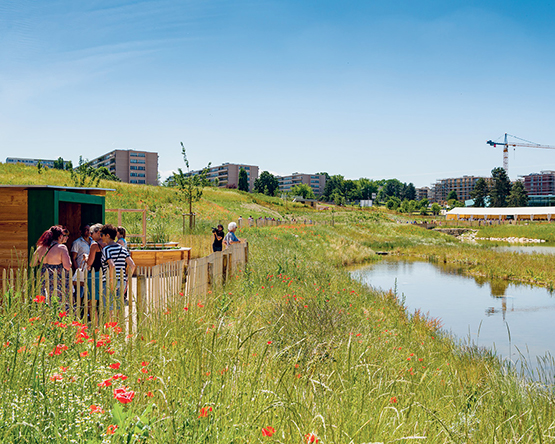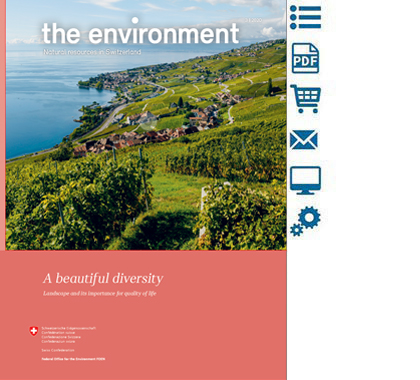Agglomerations can also contain valuable landscape and natural elements, but growing housing needsand the requirement for the consolidation of settlement areas are placing these assets under pressure.The Geneva commune of Meyrin shows that it is possible to safeguard green spaces while also connectingthem to form an ecological network.
Text: Nicolas Gattlen

Lac des Vernes on its northern outskirts.
© Laurent Barlie
Few people head to Meyrin in search of scenic gems or natural treasures. The suburban commune in north-west Geneva is more of a draw for physics buffs and architecture fans. In 1955, the European Organization for Nuclear Research (CERN) established itself on the edge of what was then an agricultural village. The research centre was soon employing thousands of specialist staff, who were housed on a specially-built estate called the Cité de Meyrin. Erected in the 1960s, the Cité is considered Switzerland’s first “satellite town” and was designed in accordance with Le Corbusier’s Athens Charter, which called for housing, industry and commerce to be located outside town and city centres and kept separate from each other. The Cité de Meyrin comprises several dozen blocks of flats, built well away from each other to allow for extensive green spaces and gathering places for the 12,000 residents.
“These open spaces improve our quality of life, and we want to preserve them at all costs,” explains Pierre-Alain Tschudi, a member of the communal executive. He refers to the “onslaught of investors and owners who would like to build houses on every spare inch of land”. Pressure on Meyrin’s open and green spaces is tremendous: it has the fastest population growth of any agglomeration commune in Switzerland (4.5% a year on average), and has ballooned from around 2,000 inhabitants in 1950 to over 25,000 in 2018.
Biodiversity a priority
In recent years, the communal authorities have been looking hard at how they can meet the increasing demand for housing without sacrificing green spaces. These are deemed to include public parks, tree-lined avenues and historic gardens such as the Jardin Botanique Alpin – a green oasis in the middle of the town. Over recent decades, road-building projects had eaten away at the perimeter of the botanical garden. In 2012, the local council applied to the canton for protected status and set about transforming the rather overgrown villa garden into an attractive destination for the entire population.
Meyrin sees its open spaces not only as places for recreation and social interaction, but also as plant and animal habitats that deserve to be safeguarded and enhanced. The commune has made conserving its biodiversity a “priority objective” for the 2015–20 legislature period. It has been promoting bio-diversity in its green spaces for over 20 years, adopting a system of “differentiated management” whereby areas are maintained with differing degrees of intensity according to their potential and function (aesthetics, social use, ecology).
Some perform all three functions, and in these areas you will find ornamental flower beds alongside neatly mown lawns and species-rich unfertilised meadows. “Differentiated management has proved successful,” says Olivier Chatelain, head of the commune’s environment department. “The town is now home to many plant and animal species that lack suitable habitats in the surrounding farmland. Take orchids, for example. We’ve recently discovered another species in a park, bringing the total recorded in Meyrin to 13.”
A green network
As well as enhancing existing green spaces, the council has also planted numerous trees and created a range of new habitats in recent years. These include a near-natural lake, Lac des Vernes, on the northern outskirts, and parks in the new Les Vergers eco-quarter. The aim is to create a “green network” spanning the entire settlement area and connecting it with the adjacent agricultural land, the forests and the canton of Geneva’s last remaining moorlands.
“Agglomeration communes have an important role to play in establishing an ecological infrastructure that will ensure the long-term preservation of space for biodiversity”, says Claudia Moll, who is responsible for landscape in built-up areas within the FOEN’s Biodiversity and Landscape Division. “85% of the population already live in urbanised areas and that number is set to rise further. The Spatial Planning Act states that these communes should primarily grow inwards. While such consolidation curbs urban sprawl into the open countryside, in many places it comes at the expense of open spaces and puts natural and landscape assets under pressure.” If these assets are to be conserved, they need to be given greater consideration in agglomeration policy and at all levels of spatial planning, explains Moll.
Optimal use of spatial planning
The FOEN-led project “Promoting biodiversity and landscape quality in agglomerations” is currently investigating how spatial planning tools can be optimally used. The project is part of the action plan to implement the Swiss Biodiversity Strategy and is being developed within the framework of the Tripartite Conference, a political platform bringing together the Confederation, cantons and communes. The findings will lead to practical re-commendations for stakeholders, showing when and where action can be taken to ensure greater biodiversity and landscape quality within agglomerations.
In the Greater Geneva area, the Projet de territoire Grand Genève 2016–30 requires the issue of landscape to be addressed across communal, cantonal and national borders. It defines spaces with special landscape functions and formulates a package of measures, including the creation of habitat corridors. A major corridor runs through the commune of Meyrin, and the local council has made a contractual commitment to protect it. This corridor – along with five other wildlife corridors – is included in the commune’s revised structure plan.
The plan also provides for the urban area to be structured by multifunctional green and open spaces. But how can this goal be reconciled with the growing demand for housing and the requirement for the consolidation of settlement areas? “Primarily by adding stories to existing buildings”, explains Pierre-Alain Tschudi. Furthermore, every extension is conditional upon outside areas being enhanced, through the planting of trees for example. Once branded “sterile”, Meyrin aspires to become a green and vibrant model for other townsto follow, says Tschudi.
Last modification 02.09.2020






